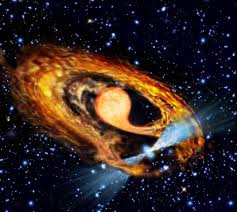New Millisecond Pulsar:

Using the Green Bank Telescope (GBT), astronomers detected a new millisecond pulsar associated with a recently observed globular cluster known as Terzan 6.
- Pulsars are rapidly rotating neutron stars that blast out pulses of radiation at regular intervals ranging from seconds to milliseconds.
- Pulsars have very strong magnetic fields, which funnel jets of particles out along the two magnetic poles. These accelerated particlesproduce very powerful beams of light.
- Often, the magnetic field is not aligned with the spin axis, so those beams of particles and light are swept around as the star rotates.
- The periodicity of pulsars is caused by these beams of light crossing the line of sight on Earth, with the pulsar appearing to ‘switch off’ at points when the light is facing away from us. The time between these pulses is the ‘period’ of the pulsar.
- Pulsars have been primarily observed at radio wavelengths.
- Pulsar masses range between 1.18 and 1.97 times that of the Sun, but most pulsars have a mass 1.35 times that of the Sun.




